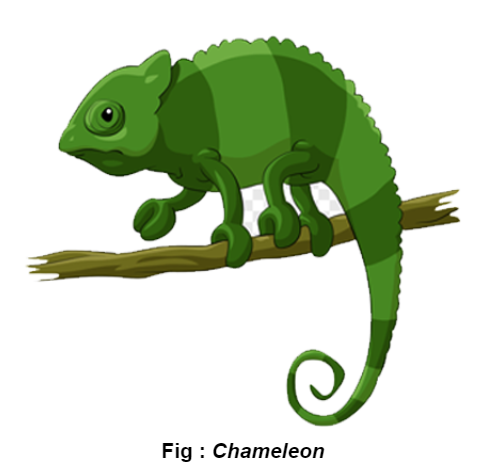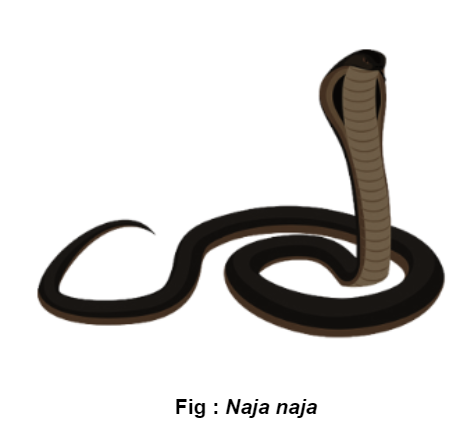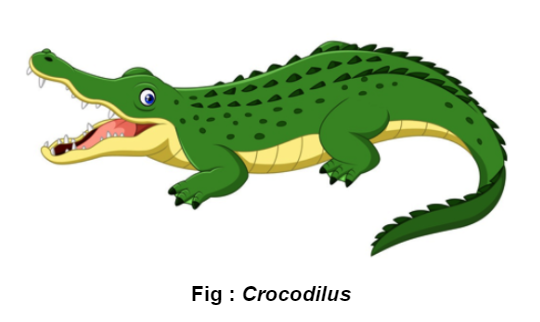-
Call Now
1800-102-2727
Reptilia
Introduction:
- The class name refers to creeping or crawling mode of Locomotion. (Latin reptum - To creep or Crawl).
- The Mesozoic era was known as the “Golden age of Reptiles”.
- Study of reptiles is known as "Herpetology".
- Study of snakes is known as “Serpentology” or “Ophiology”.
- There are about 6000 living species of Reptiles in this World.
Detailed explanation:
General characteristics of class reptilia
Habit and habitat
- They were the first successful terrestrial vertebrates.
- Some are also found in aquatic habitat.
Body
- Their body is divided into the head, neck, trunk and tail.
- Their skin is dry, rough, cornified and without glands (to prevent evaporation and to adapt to terrestrial habitat)
- Snakes & Lizards shed their scales as skin casts.
Digestive system
- A well developed and complete alimentary canal along with digestive glands are present in the digestive system.
- Teeth are acrodont, pleurodont and thecodont type.
- Tongue is protrusible.
- Complete alimentary canal opens into a common chamber called cloaca, which opens to the exterior.
Respiration
- Pulmonary respiration i.e., respiration takes place by lungs throughout their life
Circulatory system
- Usually, a three-chambered heart is present i.e., 2 auricles and 1 partially divided ventricle.
- A four-chambered heart i.e. 2 auricles and 2 ventricles is present in crocodiles.
- Sinus venosus is ill developed and truncus arteriosus is absent.
- RBCs are oval,nucleated and filled with haemoglobin.
- Well developed hepatic portal system while ill developed renal portal system is present.
Excretion
- Kidneys are metanephric type which helps in excretion and osmoregulation.
- Urinary bladder may be present.
- They are mostly uricotelic for the conservation of water.
Skeleton System
- Body is covered by horny epidermal scales or scutes.
- Endoskeleton is bony.
- Monocondylic type skull is present i.e the skull has single occipital condyle.
- Ribs are present in the neck and thorax region
Locomotion
- If present, two pairs of limbs are present and each limb has five digits. Each digit has incurved nails. (Snakes are limbless)
Nervous system
- Brain is well developed.
- 12 - pairs of cranial nerves are present.
- Lateral line system is absent.
- They do not have external ear openings.
- Tympanum represents the ear.
- Jacobson's organ (olfactory) is present at the roof of the buccal cavity in Snakes.
Reproductive System
- Reproduction is sexual.
- They are unisexual i.e sexes are separate.
- Fertilisation is internal.
- One or two penis (Hemipenis) are found in male animals as copulatory organs.
- These are mostly oviparous.
- Eggs are leathery and cleidoic, i.e. eggs are covered by a shell made up of CaCO3, to prevent dessication.
Development
- Development is direct i.e. larval stages are not formed.
Special adaptive features
- Parental care is a well marked characteristic.
- In reptiles, birds and mammals, all the three embryonic membranes amnion, chorion and allantois are present in the embryo. Yolk sac is also attached with embryos.
- These classes are grouped under the Amniota group, so reptiles are first amniotes.
- They are Poikilotherms (cold blooded animals) i.e. they can’t regulate their body temperature.
Classification of Reptilia
Living Reptiles are divided into the following subclass -
1. Sub - class Anapsida
- Skull has a solid bony roof.
- It includes only single living order chelonia
- Example - Chelone (turtle), Testudo (Tortoise)

2. Sub - class Diapsida
- Skull has two temporal vacuities.
- It is divided into three living orders
(a). Order Rhynchocephalia
- Example: Sphenodon (Tuatara) - a living fossil.
(b). Order Squamata
- It includes lizards and snakes.
- Examples of Lizards
1. Chameleon (Tree lizard) - Show metachrosis

2. Calotes (Garden lizard)
3. Hemidactylus (Wall lizard)
4. Draco (flying lizard)
5. Heloderma (gila monster)
6. Varanus (monitor lizard/chomododrago) - largest living lizard
7. Ophiosaurus (limbless lizard/ Glass snake)
- Examples of snakes
1. Naja Naja (Cobra)

2. Bangarus (Krait)
3. Vipera (Viper)
4. Hydrophis
5. Crotalus (rattlesnake)
6. Python (Ajgar)
(c) Crocodilia
Examples -
1. Crocodilus (Crocodile)

2. Alligator (Alligator)
3. Gavialis (Gharial)
Frequently Asked Questions: FAQs
Q1. Which era is known as the era of “Golden age of Reptiles”
Ans :
- The Mesozoic era was known as the “Golden age of Reptiles”.
Q2. How many chambered hearts do crocodiles have ?
Ans :
- A four-chambered heart i.e. 2 auricles and 2 ventricles is present in crocodiles.
Q3. What is the exoskeleton of reptiles made up of ?
Ans :
- The exoskeleton of reptiles is made up of horny epidermal scales or scutes.
Q4. Name any two poisonous snakes.
Ans : Naja Naja (Cobra) and Bangarus (Krait)
Q5. What is the egg shell of Reptiles made up of ?
Ans :
- The egg shell of Reptiles is made up of the crystals of CaCO3
Q6. Name any one living fossil of class Reptiles.
Ans : Sphenodon (Tuatara) - a living fossil.
Q7. What is the connecting link between amphibians and reptiles ?
Ans: Seymouria
Q8. Name the extra - embryonic membranes of Reptiles.
Ans :
- The three embryonic membranes of Reptiles are amnion, chorion and allantois are present in the embryo. Yolk sac is also attached to embryos.
Q9. Define metachrosis.
Ans :
- They show camouflage by changing the colour of the body according to their surroundings.
Q10. What is the study of snakes known as ?
Ans :
- Study of snakes is known as “Serpentology” or “Ophiology”.



